Today, you can hardly find a business that doesn’t have a website.
Businesses often use their sites as a marketing tool to increase traffic. Besides, having a website allows a business to take advantage of a considerable conversion rate. Reportedly, the global website conversion rate is 4.31% on average, which is as much as the majority of social media platforms can deliver.
But despite the fact that websites have a huge conversion potential, most of them still fail.
Back in 2013, Hubspot did research involving millions of websites to study their success rates. To their surprise, 72% of websites had a failing grade of 59 and below, which meant that they underperformed in terms of user experience.
Delving deeper into the reasons why it happened, Hubspot discovered that the majority of failed websites had some issues associated with SEO optimization. One of the main reasons was the lack of optimization for mobile devices, which we often see today as well.
This brings us to the point that, although a website can be a potent tool for your business in terms of marketing, it also can be the reason your business is losing money. Until your website has good discoverability, it won’t deliver the results that you expect.
So, there is no denying that the better part of your website’s success is behind the SEO optimization of the website copy. Today, we will take a look at how it can be achieved in our step-by-step guide with tips and examples.
I. Pre-Writing Stage
We’ll start our guide with a preparatory stage and discuss what you need to do to make the process of writing an SEO-optimized website copy go smoothly.
1. Write a Mission Statement
What is the goal of your website? The answer to this question will be the foundation you’ll use to build up the entire copy of your website.
A mission statement is a brief description of why your website exists, what kind of product it provides, who its primary audience is, and what its main goals are.
To formulate a mission statement of your website consistently, you can answer a few key questions:
- What is your product?
- Who is your website for?
- Which product needs of your audience will your website solve?
- Which information on your website is your audience the most interested in, and why?
- What’s the reason behind making your website other than financial gain?
A ready-made mission statement can later be used for the About Us page of your website. You can check out how UNICEF did it for their website:
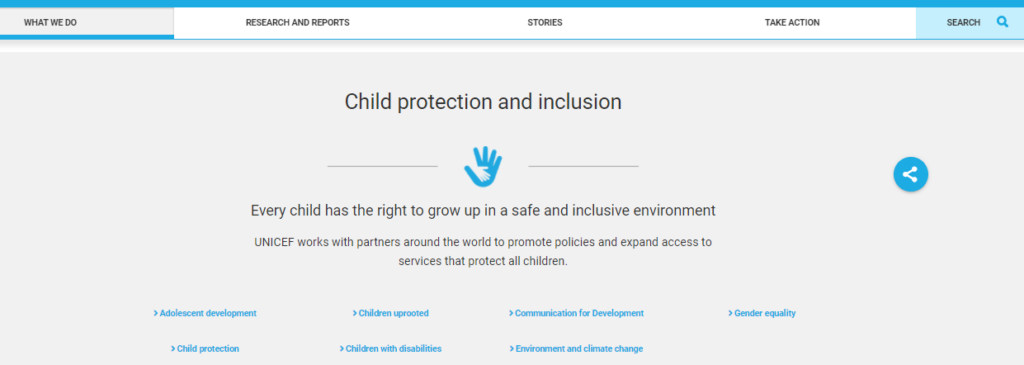
As you can see, a mission statement itself is no longer than one sentence. But it should reference the main goal of your website as well as your target audience.
And, if you decide to include it into your About Us page, you can add a few details, as UNICEF did by adding a few additional resources for their audience to learn more.
2. Research Your Target Audience
In the previous point, we spoke a lot about mentioning your target audience in your mission statement. Having a target audience figured out will help you make your website copy more focused as well as figure out the list of keywords.
Here’s what you need to do to figure out the target audience for your website:
- Start with your current customers. Who’s more interested in buying your product? Based on current purchase patterns, figure out the main demographics of your target audience. You can also check your social media accounts for some social data that shows who’s checking out your posts more frequently:
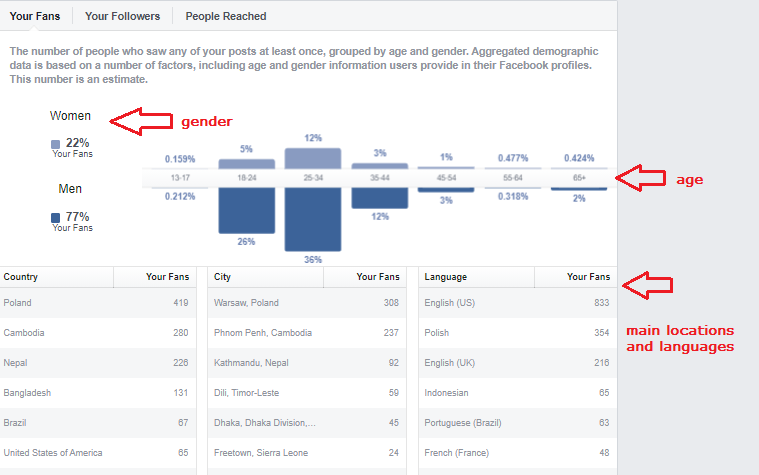
- Send out audience surveys. If you’re active on social media but don’t have a website yet, you can engage your social media followers into participating in a survey. In this survey, you can ask for information about their demographics, needs, challenges, and what they expect from a website. You can do the same through email if you have a list of email subscribers:
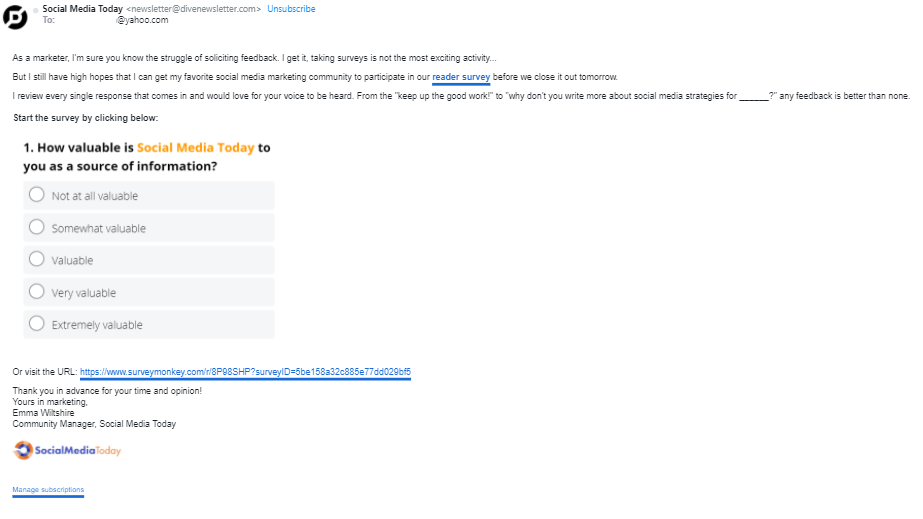
- Check out your competitors. If you have competitors with a similar product, taking a look at whom they are targeting with their website will give you valuable insights into who your target audience is. When doing competitor analysis, don’t just focus on the demographics of your competitor’s audience. Analyze it together with their product to understand the reason why people are buying it. Here’s a template you can follow to do a complete competitor analysis:
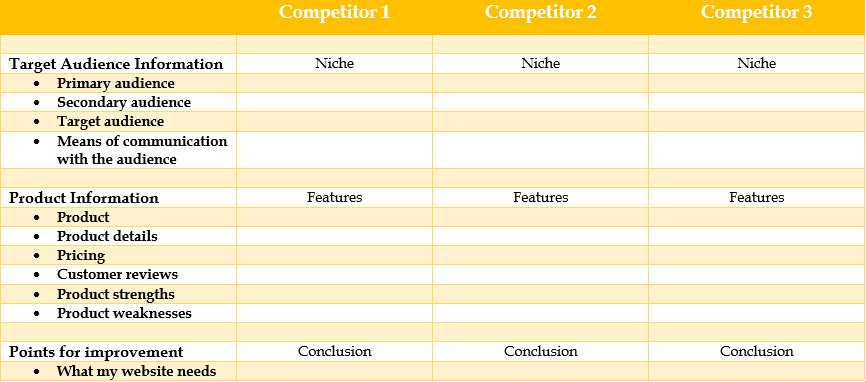
Having a ready target audience persona will help you not only optimize your website copy for SEO but also make more targeted content for your website when it’s ready.
3. Create the List of Keywords
SEO optimization cannot be achieved without a list of competitive keywords.
However, over the past few years, the understanding of what a good keyword is has changed. Now, you need to take into consideration a few other factors to make a good list of keywords to put into your website copy.
Here’s what you need to keep in mind when making your list of keywords:
- Check out the information people are already looking for. Browse Google for the queries related to your niche and your product to see which keywords people type in to find this information. The easiest way to find it is to check out the ‘People Also Ask’ section in Google search results:
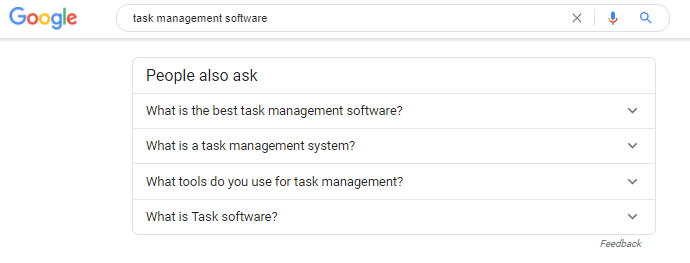
- Aim at long-tail keywords. What you probably already know about SEO is that Google likes specifics. This is the reason why long-tail keywords are better – they specify the query and help Google find the resources that the searcher is looking for. Moreover, long-tail keywords often have low competition, which is good for SEO optimization:
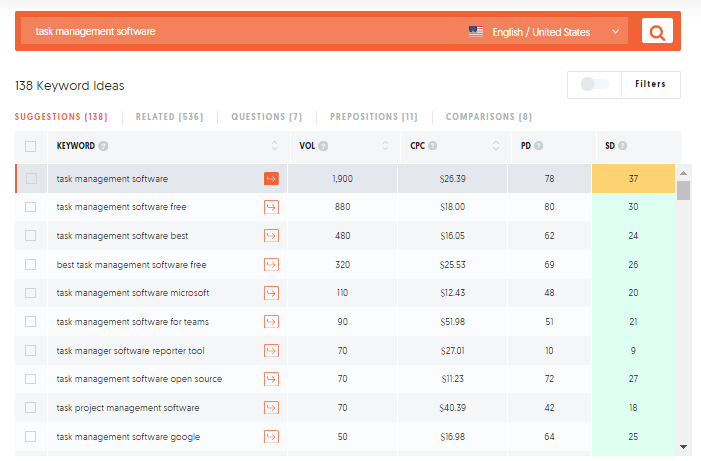
- Take advantage of the keywords your competitors are using. If you need to expand your list of keywords but are out of ideas, you can do a quick competitor analysis to see which keywords your competitors are using. From the list, you can pick the keywords that have good performance and low competition to use in your website copy:
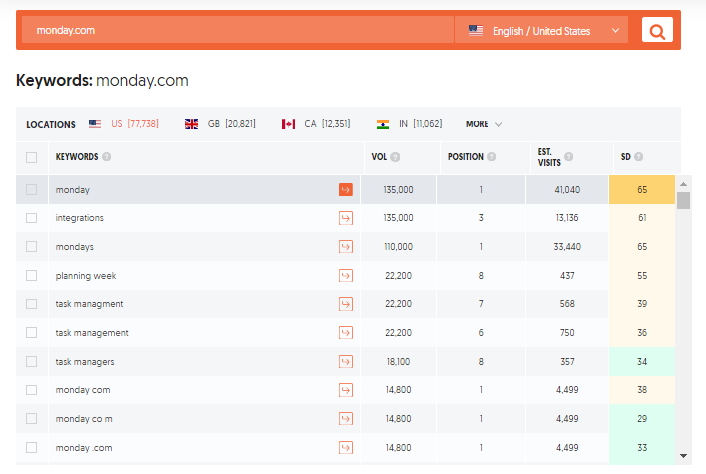
Having a basic list of keywords will not only help you optimize your website copy for SEO but also create a content cluster and develop a content strategy for your website.
The role of search intent in building the list of keywords
The above-mentioned tips work well to build a good list of organic keywords. However, it’s still not enough. To include these keywords in your website copy correctly, you need to focus on search intent.
Search intent describes the reason why the searcher is looking for certain information. This concept has been gaining momentum over the past few years because of Google’s growing interest in providing its users with the most relevant information.
Based on the types of queries, there are four kinds of search intent:
- Informational – a searcher is looking for information.
- Navigational – a searcher is looking for a certain website or a web page.
- Transactional – a searcher wants to purchase a product.
- Commercial investigation – a searcher wants to compare products or services.
When building the list of keywords for your website copy, it’s important to do it based on search intent. However, it doesn’t mean that you should focus only on one type of search intent for your website copy.
What you need to keep in mind is that not every page of your website needs to contain keywords based on all four types of search intent. For instance, the About Us page of your website can contain informational and navigational keywords, while the product pages might mostly focus on transactional and commercial investigation keywords.
So, when you have a ready-to-go list of keywords, divide it according to search intent and use these keywords only when it’s appropriate.
II. Writing Stage
Now that you have your mission statement, target audience, and the list of keywords figured out, let’s take a look at what you need to keep in mind when writing your copy.
1. Write Using the Voice of Your Ideal Customer
If you want to write an SEO-optimized website copy, it is important that you use your audience’s language to make it more relatable. The approach called the voice of the customer can help you achieve that.
What is the voice of the customer?
This is a research method used to understand and address the needs of your ideal customer. The voice of the customer approach has a few considerable benefits:
- allows you to evaluate the potential of your website and how well it can answer the customer’s needs
- gives a deeper insight into what your website copy might be lacking
- helps give your customers what they really need
Ultimately, the goal of this method is to help you speak the language that your target audience speaks and make your website copy speak to them as well.
How to determine the voice of your customers?
To help you identify the tone and style of your customer’s language, you can take advantage of:
- Customer surveys. Polls and surveys can help you better understand your customers’ perspective on certain needs and challenges related to your product.
- Social media. Social platforms can help you do some social listening without getting involved in the conversation. For example, on Twitter, you can type in the query using keywords related to your product and read Twitter threads with your target audience discussing topics connected to your product. Here, for instance, people are discussing their favorite features in task management systems:

- Customer support. The queries you receive through your customer service and live chat can help you see the needs and challenges of your customers through their eyes and figure out how to better address them in your website copy.
Additionally, you can use these methods of discovering the voice of your customers to find common keywords related to your niche and your product. This way, you’ll hit the bull’s eye with your website copy because it will directly address what your customers are looking for.
2. Assign Your Website Pages to Certain Customer Needs
While researching your target audience and its voice, you’ve figured out the needs of your customers. The list of needs that you have, as a result, will help you build the blueprint of your website copy.
If you visit a random website, you will see that it has subsections dedicated to answering certain needs and interests of its visitors. Our Myposeo.com website, for example, uses such subsections to help customers learn and navigate our products faster:

Assigning each web page to a certain customer need makes your website copy more targeted and goal-oriented.
So, make a list of customer needs and create a blueprint of your website, dividing it into pages. For every page, choose a primary keyword and a list of secondary keywords, which you will include in the header and page content.
3. Create Original Copy for Each Website Page
It’s already common knowledge that Google likes original content.
In Google’s SEO Starter Guide, you can find the confirmation of this statement. In spite of what content you are writing, Google wants you to “write an original piece of research, leveraging your unique user base.”
Another thing you need to keep in mind is that Google doesn’t like duplicated content, even within one website. So, when writing copies of the pages for your website, keep them original and oriented at a certain goal.
III. Post-Writing Stage
Once you’ve completed the draft of your website copy, it’s time to work on its improvement and put some finishing touches to make it optimized for search engines.
1. Proofread Your Website Copy for Better Readability
You might already have a good website copy on your hands, but it’s not fully optimized if it has poor readability.
It’s also not a secret that the readability of your copy impacts how successfully Google will rank it. According to the search engine, the text should be comprehensible and easy-to-understand by a reader with some or no knowledge about the subject.
Based on how well the reader knows the topic, there three main readability grades:
- 90-100 – easily understood by a 6th-grade student.
- 60-70 – easily understood by a 7th or 8th-grade student.
- 0-30 – easily understood by a college graduate.
To check the readability of your website copy, you can use tools like Hemingway App and Grammarly. You can also try thesis sites that have editors that follow the Flesch Reading System or the Gunning-Fog Index to check the readability of the text.
Keep in mind that the choice of how you will grade your website copy depends on how well your audience knows your industry, niche, product, and terminology associated with it.
2. Work on Meta Titles and Meta Descriptions
Another important step in the post-writing stage of creating a website copy is optimizing meta titles and meta descriptions.
Normally, these factors don’t have a direct impact on the SEO strategy of your website. However, they have an impact on how your website will be presented in the search results.
The majority of editors, including WordPress content editor, have a build-in meta title and meta description optimizer. However, to make sure that these features are in place, you need to check your page’s code. Here’s how both of these features look in HTML:
Meta title:

Meta description:

Keep in mind that to optimize both meta titles and meta descriptions for your website copy, you need to use primary keywords that align with certain search intent.
3. Optimize Your Website Copy for Featured Snippets
It’s good for your website to appear in the top Google search results. But it’s even better when your website appears like this:
These are features snippets, and they can give your website more traffic if you structure your website copy the correct way.
While the choice of keywords is mostly responsible for how featured snippets are organized, here’s what you can do to increase your chances that your website will be the one with featured snippets on Google search results:
- Aim for question-type queries. This way, your copy will reflect a natural answer to a searcher’s question and will have more chances of being chosen for featured snippets.
- Break your copy into sections. Use bullet points and numbered lists to make your content more scannable.
- Maintain the optimal word count. Regardless of the type of featured snippets (a paragraph, a list, or a table), make sure that it doesn’t exceed 45-50 words, otherwise it won’t appear in the Google search results in full.
So, when your website copy is ready, go through it a couple more times to optimize it for featured snippets. It will significantly improve your website’s visibility in Google search results.
Over to You
We know. In theory, writing an SEO-optimized website copy looks easy and effortless.
Unfortunately, in practice, it’s not that easy. You won’t see any immediate results, and visitors won’t come rushing in.
However, practice makes perfect. In the long run, all your efforts to optimize your website copy will bring you more conversions and more organic traffic. But while you’re just getting started, we hope that our guide will assist you during the process of writing an SEO-optimized website copy.

